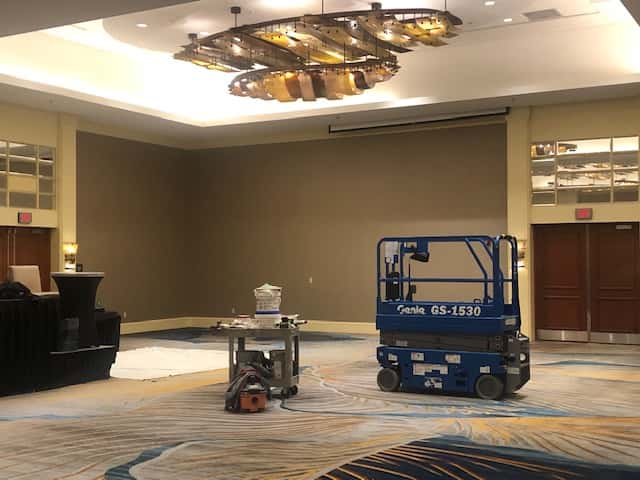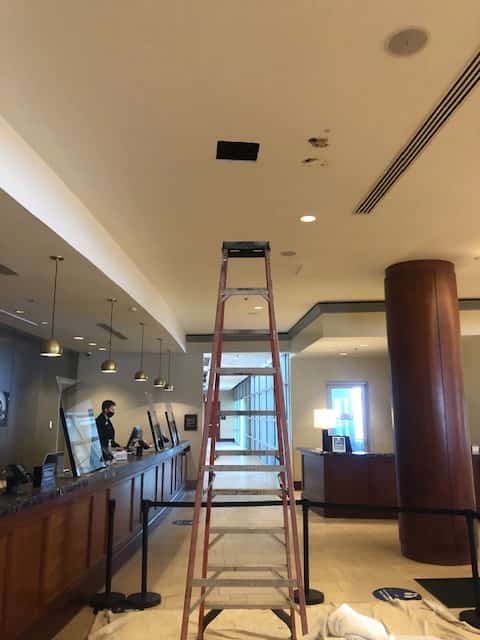Interior lift work is common on commercial painting projects. We recently used one of our man lifts on a project in Omaha. It was the only way to get to the project besides scaffolding.
The project was in the Omaha Hilton downtown. There was a leak in the ballroom ceiling that caused some damage to the drywall and paint. It was more work getting set up to do the work then the work itself.

We masked off the surroundings and had several drops down on the floor. The damage was next to and under some decorative lights. Doing the work around these intricate light fixtures was challenging.
The ceiling was scraped and then sealed with an oil base primer. Several skim coats of mud and lots of sanding and it was ready for paint. The painting was straight forward to do. Couple of coats of paint and then it was time for the worst part. Cleaning up all the drywall dust from the sanding. The dust accumulated on the underside of the light fixture. It is a delicate glass fixture and it was difficult to vacuum all the dust up without causing any damage. Lots of the areas were hard to get to even with an extension on the shopvac.
The remaining dust landed on the drops on the floor so that cleanup was easy.
At this same Hotel we did some ceiling work that we couldn’t get the lift to so we had to use a step ladder. We used a ten foot one. This repair was also a water leak but it caused enough damage that a piece of the drywall had to be replaced. pieced in some drywall and lots of sanding. It would have been much easier to do off of a lift but that was not an option.

This was a commercial interior painting project. Because we were using both a lift and a taller extension ladder, safety was a priority. It is important for business owners and homeowners to consider hiring professional painters for their projects.
Hiring a professional painter can provide a number of benefits, especially if you are inexperienced with painting or if you have a large or complex project. A professional paint contractor will recognize the importance of using ladders or operating a man lift in a safe and efficient manner.
The importance of using a man lift safely and effectively
A man lift, also known as an aerial lift or cherry picker, is a piece of equipment used to carry workers to different heights for tasks or projects including construction, painting, maintenance, and repair. While a man lift can be a useful tool, it is critical to use it correctly and carefully in order to avoid accidents and injuries. In this post, we will cover the significance of utilizing a man lift properly and successfully, as well as the potential risks when doing so.
It is important to use a man lift properly and effectively to avoid accidents and injuries. Falls from man lifts are a leading source of injuries and deaths in the construction sector, according to the Occupational Safety and Health Administration (OSHA). To utilize a man lift safely and effectively, it is important to choose the right man lift for the job, properly set it up and use it, and adhere to all safety measures and standards.
Consider the type of work you will be doing, the height of the task, and the weight capacity of the man lift when choosing the right man lift for the project. It is also important to consider the sort of surface you will be utilizing the man lift on, as certain man lifts are better suited to specific surfaces than others.
Choosing the right man lift
Man lifts come in a variety of designs, including:
Boom lifts: These machines include an extending boom that allows employees to reach heights of several hundred feet. Boom lifts are classified into two types: articulating and telescoping. The boom of an articulating boom lift can bend or pivot at several locations, allowing it to reach over obstacles or around bends. Telescoping boom lifts have a straight-out boom that allows them to reach heights in a straight line.
Scissor lifts have a platform that may be lifted and lowered utilizing a series of linked, folding supports. They are commonly employed for operations requiring a solid, stationary platform at a certain height.
Personnel lifts are more compact and portable than other forms of man lifts. They are often utilized for jobs that necessitate a vertical reach of several dozen feet or more.
Factors to consider when choosing a man lift
The type of man lift you choose will be determined by the type of task you will be doing. For example, if you will be working on a building site, you may require a high-reach boom lift. If you will be operating indoors or in a limited place, a smaller, more portable man lift, such as a personnel lift, may be required.
Height of the task: The sort of man lift required will be determined by the height of the task. A boom lift with a long reach is required if you will be working at heights of several hundred feet. You may be able to use a scissor lift or personnel lift if you will be operating at lower heights.
Weight capacity: This is a crucial issue to consider, especially if you will be working with large equipment or materials. Choose a man lift with a weight capacity that is appropriate for your needs.
Surface: The surface on which you will use the man lift will also influence your choice of man lift. Some man lifts are better suited to specific surfaces than others. Rough or uneven surfaces, for example, may necessitate a man lift with broader or more sturdy outriggers, whereas smooth surfaces may necessitate a man lift with smaller outriggers.
Tips for choosing the right man lift
Consider the following suggestions when selecting the ideal man lift for your needs:
Consult a professional. If you are unclear about which man lift is appropriate for your needs, seek advice from a specialist. They will be able to advise you on the appropriate type of man lift for your particular task or project.
Rent before you buy. If you are thinking about getting a man lift, renting one first to see if it fulfills your needs is an excellent option. This will allow you to experiment with various sorts of man lifts to determine which one works best for you.
Check pricing and features. To get the greatest bargain on a man lift, make sure to compare costs and features.
Using a manlift properly
Place the man lift on a stable, level surface: Before extending the man lift’s boom or platform, ensure sure it’s on a sturdy, level surface. If you use the man lift on uneven or unstable ground, it may topple or become unstable.
Extend and secure the boom or platform: After positioning the man lift on a stable, level surface, extend and secure the boom or platform to the appropriate height. Before climbing onto the boom or platform, be sure it is fully extended and locked into place.
Examine the controls and safety features: Before boarding the man lift, ensure that you are familiar with the controls and safety features. A control panel, an emergency stop button, and outriggers or stabilizers may be included.
Maintain three points of contact at all times. This means always having two hands and one foot, or two feet and one hand, on the man lift.
Avoid overreaching or leaning too far to one side: Resist overreaching or leaning too far to one side to keep the man lift from toppling or becoming unstable. Maintain a balanced center of gravity within the confines of the man lift.
As needed, use the controls and safety features: To adjust the height of the man lift, use the controls as specified. If an emergency occurs, use the emergency stop button or other safety features as needed.
It is important to use a man lift correctly to ensure both safety and effectiveness. You can help to prevent accidents and injuries when working at heights by following the steps for properly setting up and utilizing a man lift. Remember to select the appropriate man lift for the job, to position it on a sturdy, level surface, and to use the controls and safety features as needed to protect your safety and the safety of those around you.
Maintaining a man lift and best storage practices
Before operating the man lift, perform a thorough inspection to look for any faults or wear and tear. Examine the frame, boom, or platform for cracks, dents, or other signs of deterioration.
Repair or replace damaged parts: If any damages or wear and tear are discovered during your inspection, repair or replace the damaged parts as appropriate. This could include replacing old or damaged components like the boom or platform, as well as correcting minor damage like dents or fractures.
Follow the manufacturer’s maintenance schedule: Most man lifts come with a maintenance schedule that the manufacturer recommends. Follow this timetable to ensure that the man lift is properly maintained and operational.
Clean and lubricate the man lift: To keep it in good operating order, clean and lubricate it on a regular basis. Cleaning the frame, boom, and platform, as well as lubricating moving parts like outriggers and controls, may be required.
To avoid rust or corrosion, keep the man lift in a dry, protected location. It may be necessary to store it in a shed or garage, or to cover it with a tarp or other protective cover.
When not in use, lock the controls and safety features of the man lift to prevent unauthorized usage or tampering. Locking the control panel or connecting a padlock to the emergency stop button may be necessary.
If the man lift is powered by electricity or gasoline, make sure you disconnect it while not in use. This may entail turning off the power switch or disconnecting the gasoline supply.
Hiring a professional painter instead of using a man lift: A Safe and effective solution
A man lift can be a useful tool for doing jobs or projects that involve working at heights; however, it is critical to utilize it carefully and effectively to avoid accidents and injuries. If you’re thinking of employing a man lift for painting it might be a better idea to hire a professional painter instead.
Hiring a professional painter instead of using a man lift has various advantages:
Professional painters are educated in the safe and effective use of ladders, scaffolding, lifts, and other painting equipment. Hiring a professional painter ensures that the job is done safely and without the risk of accidents or injuries.
Professional painters have the knowledge, experience, and tools necessary to execute painting projects quickly and efficiently. This can help you save time and focus on other chores or projects.
Professional painters have the knowledge and experience necessary to deliver high-quality results. They can make recommendations for the best paint kinds, colors, and finishes for your needs and ensure that the work is performed to your satisfaction.

